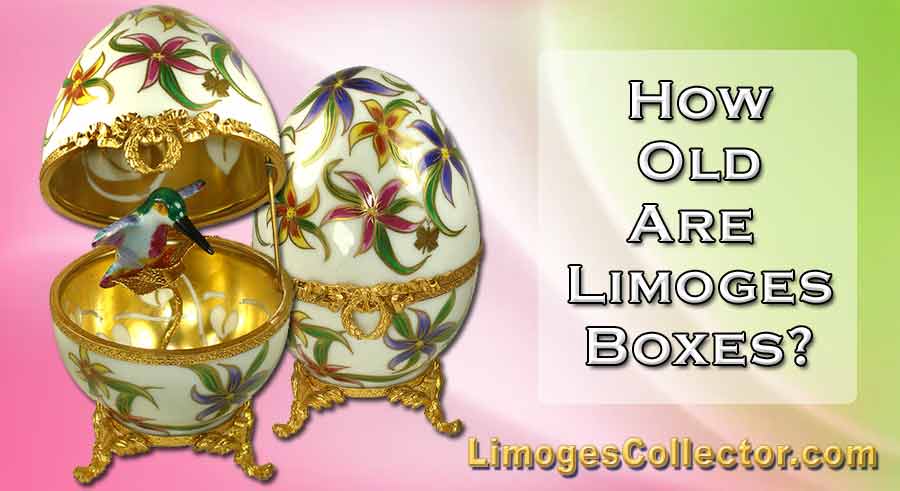How Old Are Limoges Boxes?

The origin of French Limoges boxes goes back to the 18th century when in 1768, keolin (a main ingredient in porcelain production) was first discovered in the Limousine region of central France.
Discovering how to make pure white porcelain, soon several small factories opened up in the Limoges region producing beautiful porcelain pieces. Their creations included tableware, decorative arts and, of course, miniature Limoges boxes. The white porcelain was painted by specialty artisans to create even more beautiful and outstanding art pieces.
Limoges boxes were originally of great popularity among the European royalty and the nobility of the time as they were very costly and could only be afforded by the wealthy. See Limoges Boxes Historically Collected by European Royalty.
Limoges boxes were initially used as snuff boxes and soon became a wardrobe necessity for both men and women. It is said that many of the nobility had a collection of various Limoges boxes to match different attire and occasion.
After snuff-taking fell out of fashion, Limoges boxes continued their popularity and were used to store precious small objects such as locks of hair, love notes, expensive needles, baby teeth and even small jewelry pieces. Later on, they were used to store pills and became known as fancy pill boxes.
Can the Creation Date of Limoges Boxes Be Determined?
In the mid 20th century, Limoges boxes were introduced into the United States and soon became greatly popular with collectors and gift buyers. This great popularity has continued until today and has even gained much more recognition and desirability among a much larger population.
It is very difficult, if not almost impossible, to determine the date of creation of different styles of Limoges boxes as they are not dated.
To be considered authentic, a French porcelain Limoges box must have the phrase “Peint Main” (meaning hand-painted) and “Limoges, France” in its hallmark. Some factories or Limoges artists place the stamp of the manufacture or the importer in the markings. Some of the markings are written by hand and others are stamped. Some artists place their initials as part of the backstamp and others write in the limited edition number. However, the date of creation of a Limoges is rarely ever included in the markings.
The only exception is the very specialty boxes that have been produced for a special private occasion or event. Those specialty boxes may include the date in their insignia.
The Limoges boxes that were created from the 18th century onward to the mid 20th century, are considered antiques.
Many of the Limoges boxes created from the mid 20th century to late 20th century are no longer produced and are now considered retired. Some Limoges boxes even made in the 21st century may also be considered retired for various reasons. To find out more about what can be considered a “retired” Limoges box, see What is a Retired Limoges Box and Why is it Collected.
Depending on the style and popularity, some Limoges boxes made during the 20th century continue to be produced today.
The Legacy of Limoges Porcelain and China
Limoges porcelain, renowned for its pristine white finish and exceptional craftsmanship, has a rich heritage that continues to fascinate collectors worldwide. Produced exclusively in the Limoges region of central France, this fine porcelain gained global recognition in the 18th century and remains one of the most sought-after collectibles today.
While many associate Limoges boxes with miniatures and decorative arts, Limoges porcelain also includes a wide variety of tableware and china, known for both their artistic appeal and durability. The term "Limoges China" is often used interchangeably with Limoges porcelain, though it usually refers to table settings like plates, teacups, and dinnerware sets produced by renowned manufacturers in the Limoges area.
Limoges France China: Recognizing Authenticity
One of the most frequent concerns among collectors is identifying authentic Limoges France China. To be truly considered authentic, pieces must be:
- Made in the Limoges region of France
- Stamped with marks such as “Limoges France” or “Peint Main” (meaning hand-painted)
- Often feature a factory or importer stamp, and in some cases, artist initials or edition numbers
However, many Limoges porcelain pieces lack a date, making Limoges marks and their interpretation by year a valuable skill for serious collectors. Understanding Limoges marks by year and factory-specific insignias can help determine the approximate age and origin of a piece.
Limoges Marks and Dates – How to Identify Them
Although most Limoges boxes and china don’t display a production date, collectors often refer to Limoges marks and dates to assess authenticity and age. These marks evolved over the years and differ from factory to factory.
A few notable identifiers include:
- Theodore Haviland Limoges France: One of the most well-known and respected manufacturers of Limoges France porcelain, especially popular in the late 19th and early 20th centuries. Haviland’s pieces are often finely painted and widely collected.
- Porcelain stamps and backstamps: Variations in script, logo designs, and placement offer clues about the time period and the specific maker.
Many enthusiasts use Limoges china patterns identification guides to help distinguish older series, rare patterns, and factory variations — especially helpful when dealing with Limoges porzellan alte serien (old Limoges porcelain series), which remain highly collectible in Germany and other parts of Europe.
Limoges China Patterns Identification: Finding Vintage Treasures
If you're interested in collecting Limoges France china, understanding how to identify vintage or discontinued patterns is key. Some tips:
- Compare your pattern with archived catalogs or image databases of Limoges china patterns
- Look for border detailing, floral motifs, gold trims, and hand-painted touches that are unique to certain factories
- Take note of the shape and size of the porcelain pieces, as older series may differ from modern reproductions
Why Limoges France Porcelain Is a Collector’s Dream
From its royal origins to its global appeal, Limoges France porcelain continues to be admired for:
- Its fine kaolin-based composition that gives it strength and translucency
- Exquisite hand-painted designs, often done by master artisans
- A wide variety of themes, from florals to animals, historic scenes to whimsical modern pieces
- The investment potential, especially for discontinued or limited-edition items
Collectors often seek pieces from Theodore Haviland Limoges France, as they hold a special place in the history of porcelain art and are appreciated for their refined elegance.
The Reasons Why Limoges Boxes Are Collected
Limoges boxes are loved, admired and collected today for many reasons, mainly their beauty and artistry. See Are Limoges Boxes Worth Collecting?
The exceptional artistry of porcelain painting, the multitude of shapes and themes, the miniature art form and the investment worth of French Limoges boxes make them truly desirable and valued.
At LimogesCollector.com, we are proud to offer a vast selection of the highest quality French Limoges boxes in every style and theme and for every occasion. You can be sure to find a Limoges box (or two or three) that you can’t do without with every visit.
Please take a moment to browse our collection and see what catches your fancy today!









